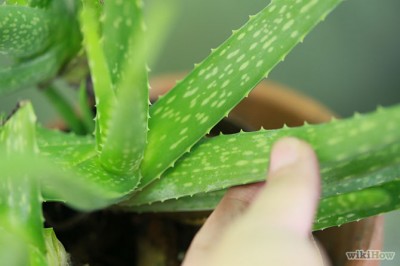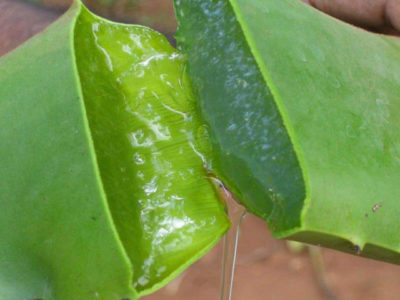
Aside from its beauty and ease of care, people often use aloe vera as an herbal remedy.
Aloe vera is a popular succulent plant with a rich history. Aside from its beauty and ease of care, aloe vera is often used as an herbal remedy. The plant is referred to as “the burn plant,” “the wonder plant,” “the medicine plant,” or “the silent healer,” all in reference to its medicinal capabilities.
Everyone should have an aloe vera plant, whether it’s in a pot on their porch or in their garden (zone permitting). Here are five reasons why.
1. Aloe Is More Effective At Healing Burns And Injuries Than Typical Ointments
For first and second degree burns you can’t beat aloe vera. Not only does the gel take away pain and cool the burn, but it also speeds up healing compared to traditional ointments. In one study done at Naresuan University in Thailand, researchers found that participants who were treated with aloe gel healed almost nine days sooner than those treated with traditional ointments.
Aloe vera gel also is equally or more effective than ointments for treating various rashes, cuts, and abrasions. It also works well for blisters and other open surface wounds. Aloe gel works well in part because it protects the injury when layered as a thick gel.
The wonderful thing about aloe vera is that you can just clip off a leaf, cut it open, and put the gel directly on the wound. You can either leave it be or cover it with a bandage. According to most studies done, you really can’t overuse the gel, so feel free to apply it as often as you feel necessary. Since the gel is so gentle on the skin, you can pretty much use it on anyone. It helps as a non-toxic way of treating scrapes on young kids.
2. Keeping A Few Of These Plants Indoors Will Improve Air Quality
NASA has rated aloe vera as one of their top 10 approved plants for improving indoor air quality. The way the plant does this is by absorbing and neutralizing volatile organic compounds (VOCs), such as formaldehyde and benzene. The harmful VOCs found in everything from plastics to household cleaners and prolonged exposure to them can cause a variety of health issues.
While an aloe plant isn’t going to completely clean your air, just having one plant in every room can actually make quite a difference. These plants are easy to care for and beautiful, so why not have a few pots around your home?
3. Aloe Gel Helps Heal Various Skin Conditions
When summer rolls around it’s pretty easy to find those bottles of green aloe gel in the same aisles as sunblock. Remember that study on burns under reason number one? The typical sunburn is a first-degree burn, which may be characterized by tender, red skin that feels hot. Aloe gel works perfectly for sunburns and this reason alone makes it a very popular product.

Aloe gel works perfectly for treating various skin conditions, and this makes it a very popular product.
Some other skin conditions or ailments that aloe treats include acne, painful pimples, psoriasis, and eczema. Aloe gel has also proven that it can revive skin from frostbite. Furthermore, many people have used this plant to treat warts.
4. Aloe Vera Reduces Inflammation And Itchiness From Bug Bites And Stings
Aloe vera is anti-inflammatory by nature, either when ingested or applied topically. Just as the gel soothes and burns, it also helps take away the itchiness and pain from bug bites or stings. Applying the gel straight from the leaf to a bug bite will either reduce swelling or prevent it altogether if you attend to it quickly enough.
An additional benefit of using aloe to treat bug bites is that it reduces the risk of infection. Most of the bug bites or sting sites get infected because a person scratches to try and alleviate the itch. Aloe is anti-bacterial in nature, so if you have been scratching then you’ll get a dose of infection protection.
Emergency Power Supply In The Palm Of Your Hand… Literally
5. Consuming Aloe Soothes The Stomach And Improves Overall Digestion
Aloe vera isn’t just a topical treatment. You can use aloe gel (and sometimes the whole leaf –skin and all) to help with various digestion issues by ingesting it. There have been a couple of different studies done regarding the effectiveness of aloe on different internal issues. In one study, researchers found that aloe gel had a therapeutic effect on inflammatory bowel disease (IBD). Aloe vera, if ingested, also is a good natural laxative for people experiencing constipation. In fact, aloe is so effective as a laxative that you cannot use too much if you are trying to treat a different issue.
Harvesting aloe vera is the same for both internal and topical use. Cut off a leaf, slice it down the middle, and spread it to access the gel. Then you can use a spoon to take out all of the gel. This gel can then mix in water or juice, or you can add it to a smoothie. Some people put the entire leaf into the blender, although there is no real benefit except for some extra fiber.
Acquiring Aloe Vera
It’s possible to start your own aloe vera plants from seed, although there will be a long wait before you can harvest any leaves. A better idea would be to buy small plants from a nursery or online. Big retailers, hardware stores, and even grocery stores often carry small aloe plants for a good price.
Aloe vera is super easy to care for and really difficult to kill, which is a bonus for you “black thumbs” who struggle to keep houseplants alive.
You may also enjoy reading an additional Off The Grid News article: How To Know If Your Store-Bought Aloe Vera Gel Is Fake
What are other ways you’ve used aloe? Share your tips in the comments below.
 Off The Grid News Better Ideas For Off The Grid Living
Off The Grid News Better Ideas For Off The Grid Living



